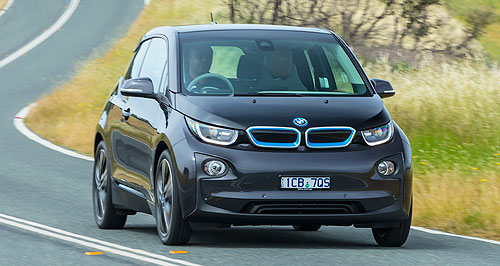Make / Model Search
News - Market Insight - Market Insight 2015Market Insight: The great green car dilemmaGreen machine: BMW’s i3 might now be the greenest model in the small-car segment but it remains a niche proposition in sales terms. Gulf between greenest cars, top sellers widens with new tech vs traditional valuesGallery Click to see larger images 24 Apr 2015 By TERRY MARTIN IF AUSTRALIAN new-vehicle buyers based their purchase decisions on best-in-class CO2 output, only two segments would offer up a vehicle with a traditional petrol internal combustion engine – and one of these, the Holden Ute, will be off the market by the end of 2017. That leaves only the Fiat 500 micro-car – which has a super-efficient 0.9-litre two-cylinder TwinAir engine in its arsenal – burning the wick for IC petrol engines while every other segment now offers up either full-electric, hybrid (petrol and diesel) or diesel engines as the cleanest in class. This is a sign of the times, but in sales terms traditional petrol-engined vehicles last year still accounted for the vast majority of all new registrations – 68 per cent (ex-heavy commercial) – while increasingly advanced diesel models made up 31 per cent, leaving hybrid, electric and LPG to scrap over the remaining single digit. In its just-released report into carbon dioxide emissions for new Australian light vehicles in 2014, the National Transport Commission (NTC) has again emphasised that if buyers routinely chose the best-in-class vehicle the national CO2 emissions would be so much lower that we would be leading the rest of the world rather than lagging well behind comparable markets. Were this the case, and without including vehicles with zero tailpipe emissions in its calculations, the NTC believes Australia’s new-vehicle CO2 average would have been at 95 grams per kilometre last year – the point Europe as a whole (across 28 EU member countries) plans to be by 2021 – whereas in fact we came in at 188g/km. The difference in CO2 between the top-selling models in each class and the greenest is striking, particularly as hi-tech new vehicles with alternative powertrains – often created as a direct result of the tough regulations in Europe – trickle into key segments here. In Australia’s biggest-selling segment – small cars – the leading Toyota Corolla’s average CO2 emissions (154g/km) were more than 1000 per cent above BMW’s new i3 REX plug-in hybrid (13g/km), with the NTC leaving the battery-operated zero-emissions i3 BEV and Nissan’s Leaf out of the equation. The differences are smaller in other segments, but no less significant, with Hyundai’s top-selling i20 light car (149g/km) emitting 65 per cent more CO2 on average last year than the Fiat 500 and the Toyota Prius C petrol-electric hybrid (both 90g/km), while the Korean brand’s leading light-sized SUV, the iX35 (208g/km), sent 102 per cent more CO2 into the atmosphere than Peugeot’s class-greenest diesel-powered 2008 (103g/km). The arrival of Mitsubishi’s Outlander PHEV plug-in hybrid (49g/km) in the small/medium SUV class last year sent the emissions of Mazda’s top-selling – and by no means high-polluting – CX-5 (158g/km) soaring 223 per cent above the new entrant, while the market-leading mid-size Camry sedan at 183g/km (not including hybrid) was 62 per cent higher than the new diesel-electric Mercedes C300 (113g/km) launched late in the year. Mercedes’ related E300 hybrid (113g/km) was also the standout green performer in the large-car class, emitting 109 per cent less CO2 than the top-selling Holden Commodore (236g/km), while the Porsche Panamera S E-Hybrid (71g/km) was deemed the greenest upper-large car – notwithstanding the arrival late last year of the zero-emissions Tesla Model S. By comparison, the top-selling Chrysler 300 currently delivers between 219g/km and 303g/km, depending on the powertrain. Among people-movers, Honda’s sales-leading Odyssey (183g/km) was found to emit 53 per cent more CO2 than the new-generation C4 Grand Picasso (120g/km), and in the sportscar class Toyota’s top-selling 86 coupe (174g/km) was 254 per cent higher in CO2 terms than BMW’s hi-tech new i8 plug-in hybrid supercar (49g/km). Large SUVs, which are not known for their low emissions, saw Jeep’s Grand Cherokee (227g/km) as the segment sales leader last year, but with a 53 per cent higher CO2 emissions intensity than Subaru’s new Outback diesel (148g/km). It was a similar story in the upper-large class, with the all-conquering Toyota LandCruiser (277g/km) deemed 49 per cent more polluting than the diesel-powered Range Rover (186g/km). Holden’s aforementioned locally built ute was the standout in the 4x2 pick-up/cab-chassis segment with 168g/km, 51 per cent lower than the top-selling Toyota HiLux 4x2 (254g/km), but the unique Commodore-based model will be discontinued here in 2017 when the car-maker closes its factories. The dominant HiLux was also a paler shade of green than some of its rivals in the equivalent 4x4 class (226g/km), emitting 16 per cent more CO2 than the darker green but far less popular SsangYong Actyon diesel (195g/km). Among the vans, Toyota’s HiAce (242g/km) was 99 per cent higher than the Citroen Berlingo diesel (122g/km), not counting the arrival of Renault’s full-electric Renault Kangoo ZE which is currently being trialled by Australia Post. With so many advanced low-emissions vehicles now available, and many more on their way, the potential for lowering the intensity of Australia’s CO2 is enormous. But getting new-car buyers to actually take the green route remains a long-term and incredibly difficult proposition.  Read more20th of April 2015  Market Insight: New-car emissions down but rate slowsTailpipe emissions in Australia fall, but 2.3 per cent drop the slowest since 20096th of January 2015  VFACTS: Groundhog day for Aussie car marketAustralia locked on 1.1 million new vehicle sales as showroom gains stall2nd of June 2014  Car buyer habits keep nation’s CO2 levels highEnvironment takes back seat as Aussie new-car buyers stick to bigger, thirstier cars |
Click to shareMarket Insight articlesResearch Market Insight Motor industry news |















Facebook Twitter Instagram